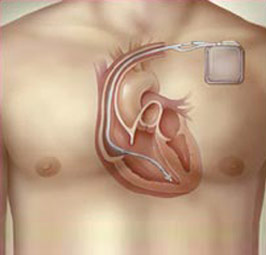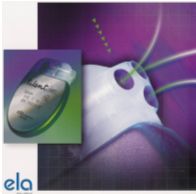Pacemakers
Implantable Cardiac Pacemakers
 Pacemakers have been used in the treatment of bradycardia for more than 40 years. Bradycardia is a condition in which the heart beats at an unusually slow rate (less than 50 to 60 beats per minute).
Pacemakers have been used in the treatment of bradycardia for more than 40 years. Bradycardia is a condition in which the heart beats at an unusually slow rate (less than 50 to 60 beats per minute).
When a slowed or irregular heart rhythm is detected, the pacemaker delivers precisely-timed electrical impulses to the heart to restore a normal heart rate.
A pacemaker consists of:
- A pulse generator with battery and circuitry providing electrical energy and timing
- One or two pacing leads insulated wires that carry electrical impulses to the heart (pacing function) and information about the heart s natural activity back to the pulse generator (sensing function)
There are different types of pacemakers:
- Single chamber pacemakers use one pacing lead placed in the right atrium (upper chamber of the heart) or in the right ventricle (lower chamber of the heart).
- Dual chamber pacemakers use two pacing leads, one in the right atrium and the other in the right ventricle, used to restore a physiological sequence of cardiac activation. Electrical pulses delivered to the heart are timed so that atria and ventricles are synchronized with each other.
Most of today s pacemakers incorporate one or two sensors to detect the patient s activity and adjust the patient s heart rate to accelerate or slow down as needed.
The most common implantation method is to first insert the pacing lead is into the heart through a vein.
The pulse generator is then implanted under the skin in the upper chest area near the collar bone and connected to the pacing lead. The procedure is relatively simple and can be performed under local anesthesia.
To change the pacemaker settings to meet the patient s needs, the physician uses a programmer which can send signals to and receives signals from the pacemaker on radiofrequency waves without surgery.
Biventricular Pacemakers MSP
 The biventricular pacemaker has a lead that stimulates the left ventricle in addition to the standard pacemaker lead(s).
The biventricular pacemaker has a lead that stimulates the left ventricle in addition to the standard pacemaker lead(s).
Biventricular pacemakers are specifically designed to treat congestive heart failure whereas pacemakers treat cardiac conditions that involve bradycardia.
The implantation procedure is done under local anesthesia like for a standard pacemaker.
However, it lasts longer because of the need to insert the third lead which paces the left ventricle.
How is ELA engaged in HF treatment?
Since 1994, ELA has been actively engaged in developing new therapeutic solutions to treat congestive heart failure. Close collaboration between ELA’s engineers and world-renowned cardiologists led in 1994 to the world’s first implant of an ELA pacemaker with a four-chamber configuration and to the initiation of the MUSTIC study in 1996.
The MUSTIC (Multi-site Stimulation in Cardiomyopathy) trial, a randomized and controlled study designed to evaluate the safety and clinical efficacy of biventricular pacing or cardiac resynchronization in patients with congestive heart failure (CHF), was the first to show an immediate marked improvement in the well-being of patients and an interruption of their deterioration towards requiring a heart transplant.
Other studies have suggested that the device may improve the quality of life for many heart failure patients. Researchers are also trying to determine if biventricular pacemakers can increase survival in heart failure patients.
VVI - OPUS S 4124
Single chamber pacemaker, with programmable polarity for pacing and sensing.
Due to the algorithm RATE SMOOTHING the pacemaker smoothes the inherent cardiac rate to the basic frequency, preventing from unpleasant results of a sudden bradycardia or a cardiac pause. It also includes diagnostic programmes, statistics, noninvasive control of pacing parameters etc.
VVI - RHAPSODY S 2130
Single chamber pacemaker of new technology for more longevity, with programmable polarity for pacing and sensing.
- Rate smoothing
- Auto threshold
- Auto Sense
It also includes diagnostic programmes, statistics, noninvasive control of pacing parameters etc.
VVIR - RHAPSODY SR 2210
Single chamber pacemaker of new technology.
- Automatic Calibration
- ACCELEROMETER
It also includes diagnostic programmes, statistics, noninvasive control of pacing parameters etc.
VVIR - TALENT II SR 133
Single chamber pacemaker.
- Auto threshold
- Auto Sense
- Automatic Calibration
- Rate Responsive
- Dual Sensor (Twin Trace)
It also includes diagnostic programmes, statistics, noninvasive control of pacing parameters etc.
VVIR - SYMPHONY SR 2250
Single chamber pacemaker of new technology for more longevity.
- Auto threshold
- Auto Sense
- Automatic Calibration
- Rate Responsive
- Dual Sensor (Twin Trace)
It includes an algorithm for auto-set of all the refractory periods.
It also includes diagnostic programmes, statistics, noninvasive control of pacing parameters etc.
VDDR - TALENT 3 VDR 263
New generation VDD pacemaker.
- Auto threshold
- Auto Sense
- Automatic Calibration
- Rate Responsive
- Dual Sensor (Twin Trace)
- Sleep Apnoea
- AIDA
It also includes a unic mode VDD/VVI-R that it can be used to patients with AV block and atrial arrythmia.
Diagnostic programmes, statistics, noninvasive control of pacing parameters etc.
VDDR - SYMPHONY VDR 2350
New generation VDD pacemaker for more longevity.
- Auto threshold
- Auto Sense
- Automatic Calibration
- Rate Responsive
- Dual Sensor (Twin Trace)
- Sleep Apnoea
- AIDA
It also includes a unic mode VDD/VVI-R that it can be used to patients with AV block and atrial arrythmia and an algorithm for auto-set of all the refractory periods..
Diagnostic programmes, statistics, noninvasive control of pacing parameters etc.
DDD - TALENT II D230
Dual chamber pacemaker of new technology that provides effectively therapeutic functions.
- Auto threshold
- Auto Sense
- Fallback – Mode Switching
- PMT protection
- AIDA
- DDD - VVIR mode with "MINUTE VENTILATION".
- DDD/AMC mode
Diagnostic programmes, statistics, noninvasive control of pacing parameters etc.
DDD - RHAPSODY D 2410
Dual chamber pacemaker of new technology that provides effectively therapeutic functions.
- Fallback Mode Switching
- DDD-VVIR mode mode with “ ACCELEROMETER ”
- PMT protection
- DDD/AMC mode
- AIDA+
- Automatic calibration of the refractory periods.
Diagnostic programmes, statistics, noninvasive control of pacing parameters etc.
DDD - SYMPHONY D 2450
Dual chamber pacemaker, for more longevity.
- Auto Threshold
- Auto Sense
- Fallback Mode Switching
- DDD-VVIR mode “MINUTE VENTILATION”
- PMT protection
- AAI/SAFE R mode
- DDD/AMC mode
- AIDA+
- Auto-set of the refractory periods.
Diagnostic programmes, statistics, noninvasive control of pacing parameters etc.
DDDR - RHAPSODY DR 2510
New generation dual chamber pacemaker.
- Accelerometer
- Automatic Calibration
- Auto Threshold
- Auto Sense
- Fallback – Mode Switching
- DDD/AMC mode
- AIDA+
- Auto-set of the refractory periods
Diagnostic programmes, statistics, noninvasive control of pacing parameters etc.
DDDR - RHAPSODY +DR 2530
New generation dual chamber pacemaker.
- Minute Ventilation
- Automatic Calibration
- Auto Threshold
- Auto Sense
- Rest Rate
- Fallback Mode Switching
- PMT protection
- DDD/AMC mode
- AIDA+
Diagnostic programmes, statistics, noninvasive control of pacing parameters etc.
DDDR - TALENT 3 DR 253
New generation dual chamber pacemaker with special algorithms for the protection of the patient from atrial fibrillation.
- Twin Trace
- Sleep Apnoea
- Automatic Calibration
- Fallback Mode Switching
- PMT protection
- DDD/AMC mode
- Rest Rate
- AIDA+
Diagnostic programmes, statistics, noninvasive control of pacing parameters etc.
DDDR - SYMPHONY DR 2550
New generation dual chamber pacemaker with special algorithms for the protection of the patient from atrial fibrillation.
- Twin Trace
- Automatic Calibration
- Fallback Mode Switching
- PMT protection
- DDD/AMC mode
- AAI/SAFE R mode
- Rest Rate
- AIDA+
Diagnostic programmes, statistics, noninvasive control of pacing parameters etc.
MSP - TALENT 3 MSP DDD-R 353
New technology biventricular pacemaker specialized for patients with heart failure. It includes algorithms for the protection of the patient from atrial fibrillation.
- Twin Trace
- Sleep Apnoea
- Automatic Calibration
- Fallback Mode Switching
- PMT protection
- DDD/AMC mode
- Rest Rate
- AIDA+
Diagnostic programmes, statistics, noninvasive control of pacing parameters etc.